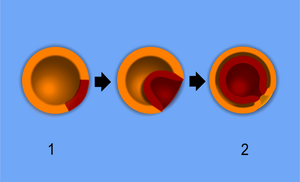Assessment |
Biopsychology |
Comparative |
Cognitive |
Developmental |
Language |
Individual differences |
Personality |
Philosophy |
Social |
Methods |
Statistics |
Clinical |
Educational |
Industrial |
Professional items |
World psychology |
Biological: Behavioural genetics · Evolutionary psychology · Neuroanatomy · Neurochemistry · Neuroendocrinology · Neuroscience · Psychoneuroimmunology · Physiological Psychology · Psychopharmacology (Index, Outline)

1 - blastula, 2 - gastrula; orange - ectoderm, red - endoderm.
The gastrula phase of embryonic development is seen in all animals except the sponges. It follows the blastula phase. The purpose of gastrulation is to position the three embryonic germ layers, the endoderm, ectoderm and mesoderm. During gastrulation, embryonic cells migrate through an opening within the embryo known as a blastocoel.
There are five main types of cell movements in gastrulation - ingression, involution, invagination, delamination and epiboly. Ingression is the movement of single cells inwards, involution is the inturning of a lower cell layer caused by movement of the upper layer, invagination is an infolding, or poking, of cells, delamination is when one sheet of cells split into two, and epiboly is when the embryo is encompassed by the ectoderm. Once gastrulation is complete, all germ layers are in the correct location and further growth and organogenesis begins.
es:Gástrula eo:Gastrulo
| This page uses Creative Commons Licensed content from Wikipedia (view authors). |